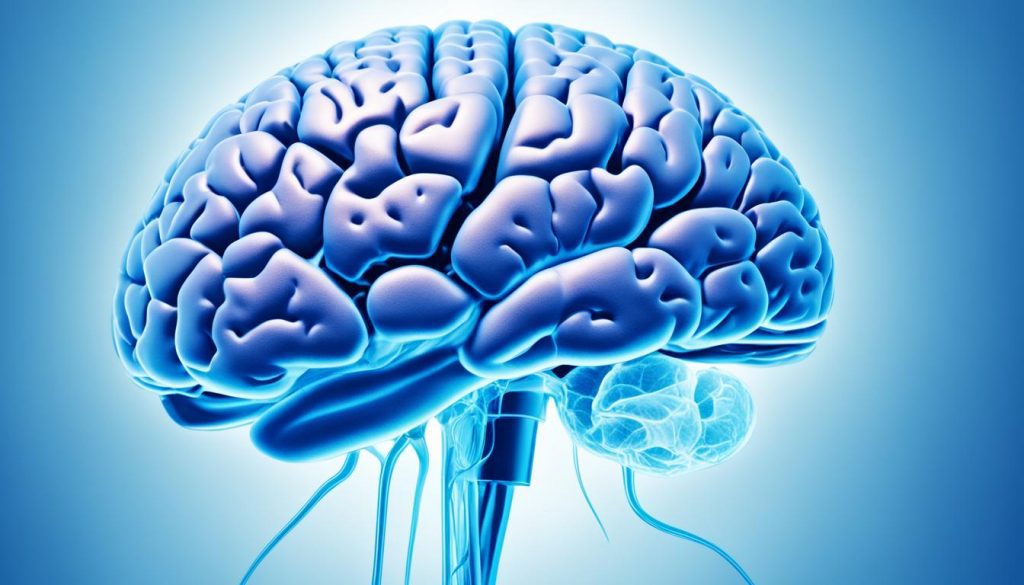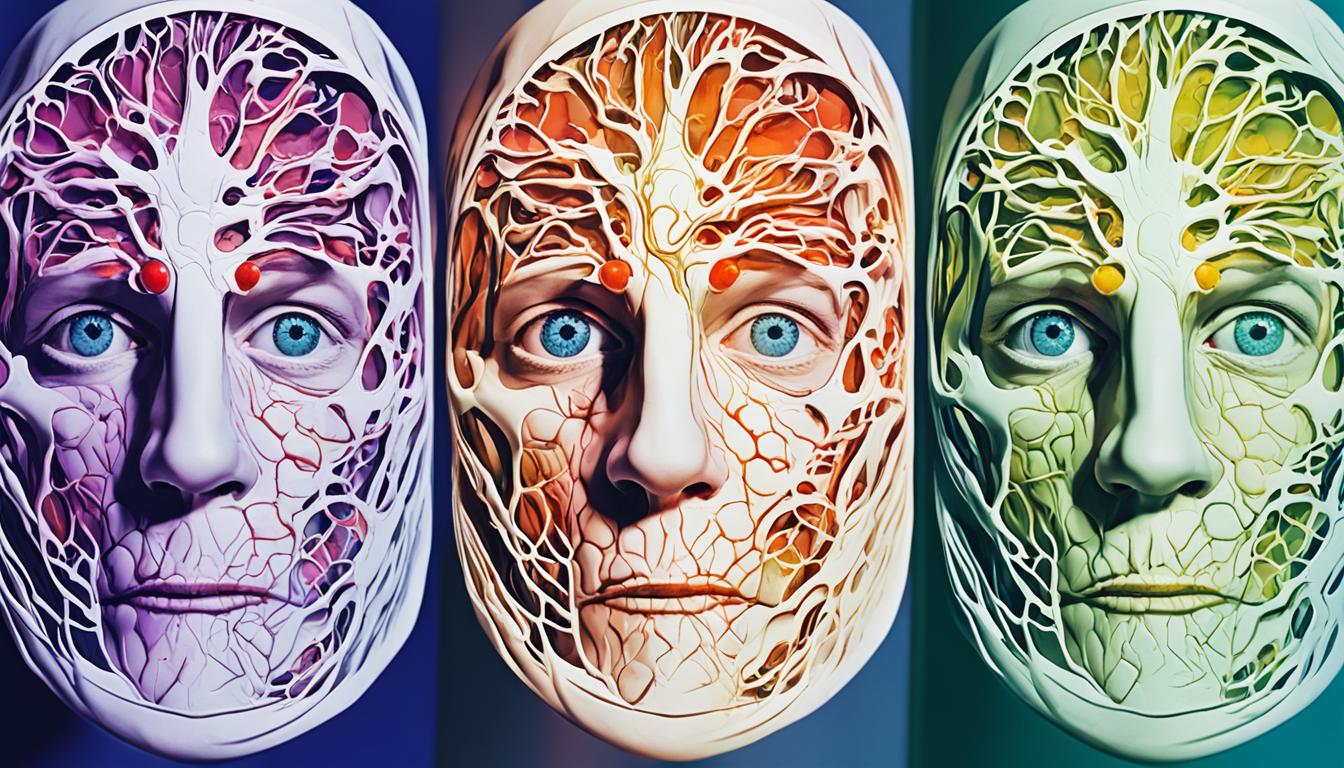Body dysmorphic disorder (BDD) is a psychiatric condition. It affects about 1-2% of the population, more so among girls. It usually starts in the teen years and can worsen over time. People with BDD are overly concerned with imagined flaws in their looks. This obsession can cause a lot of distress and affect their life quality.
The causes of BDD are believed to be genetic and environmental, like past abuse or neglect. The way we diagnose BDD has gotten better recently, and there are treatments available. People might take medication, such as SSRIs, or go through cognitive-behavioral therapy. Research is also looking into stem cell therapy as a possible treatment for BDD.
Key Takeaways:
- BDD is a psychiatric condition affecting 1-2% of the population, with higher prevalence among girls.
- BDD is characterized by a preoccupation with perceived flaws in one’s appearance, leading to severe distress.
- Genetic and environmental factors contribute to the development of BDD.
- Diagnosis of BDD has improved, and treatment options include medication and therapy.
- Stem cell therapy shows promise as a potential treatment for BDD.
Symptoms of BDD
Body Dysmorphic Disorder (BDD) is a condition with various symptoms. These symptoms affect a person’s mental and emotional health. It’s key to spot these signs early on.
Common signs of BDD include:
- Preoccupation with perceived flaws: Individuals with BDD fixate on small or imaginary flaws. These can range from acne scars to signs of aging.
- Exaggerated perception of flaws: Those with BDD see their flaws as worse than others do. They believe these imperfections are glaringly obvious.
- Psychological distress: Fixating on these flaws can lead to severe distress. This includes feelings of anxiety, shame, and depression.
- Mirror checking and avoidance: Some constantly check mirrors for reassurance about their looks. Others avoid mirrors to not face their perceived flaws.
- Seeking medical advice and treatments: Many turn to doctors and cosmetic procedures. They hope to fix what they see as wrong with their appearance.
The severity of BDD symptoms can vary. This can deeply affect a person’s life.
Case Study: Correlation between BDD Symptoms and Psychological Distress
| Participant | BDD Symptom Severity (rated on a scale of 1-10) |
Psychological Distress (rated on a scale of 1-10) |
|---|---|---|
| Participant A | 8 | 9 |
| Participant B | 4 | 3 |
| Participant C | 10 | 10 |
A study looked at the link between BDD symptoms and distress. The above table shows three people’s symptom and distress levels. This shows how BDD severity is linked to psychological distress.
By knowing the symptoms of BDD and their effects, we can aim for early detection. This means getting diagnosed and treated sooner. This helps reduce suffering and improves well-being.
Causes of BDD
Body dysmorphic disorder (BDD) is a complex mental issue. The exact causes are not fully known. Still, it’s thought that genes and environment both have roles.
Genetic Factors:
Genetic factors greatly influence BDD. If BDD runs in the family, there’s a higher chance of getting it. Research found that certain genes make people more prone to BDD.
Environmental Factors:
Environmental factors like being mistreated can play a part in BDD. Negative experiences in childhood or teen years can affect mental health and body image issues. Cultural and social views on looks also add to the problem.
Studies using brain scans and psychological tests show a key issue in how BDD sufferers process visuals. They obsess over tiny, usually unseen, flaws. This makes their distress worse.
BDD comes from both genes and environment. They combine and result in the disorder. Knowing these causes helps in creating better treatments for BDD.
Genetic and Environmental Factors Contributing to BDD
| Genetic Factors | Environmental Factors |
|---|---|
| Family history of BDD | Abuse or neglect |
| Specific genetic variations | Traumatic experiences |
| Societal pressures and cultural norms surrounding appearance |
Diagnosis of BDD
Over the years, the way we diagnose BDD has gotten better. The DSM 5 lists the latest criteria. These guidelines help doctors understand and identify the disorder accurately.
People with BDD worry a lot about how they look. They may think they have flaws that others don’t see. They might spend hours checking in the mirror or asking others if they look okay.
Many with BDD also have other issues like depression or anxiety. This can make their struggle harder. They might even think about suicide. That’s why knowing what’s wrong and getting help is crucial.
To find out if someone has BDD, they need a detailed mental check-up. This can include talking to a psychologist, filling out forms, and observing how they act. Since they might not realize how serious their worry is, it’s important for them to feel they can talk openly and without fear of judgment.
If diagnosed correctly, people with BDD can get the right help. Getting help early can make a big difference. It can help them feel better about themselves and live a better life.
Treatment for BDD
Treating BDD usually means therapy and sometimes medicines. Cognitive-behavioral therapy (CBT) helps patients stop negative thoughts and learn better ways to cope. And medicines, like SSRIs, can make them feel less anxious or sad.
There are also support groups and resources that help people feel they’re not alone. Sharing stories and tips can be a big help in recovery.
Getting better involves working with experts who understand BDD. With the right support, people with BDD can feel better about themselves. They can overcome their fears and enjoy life more.
Stem Cell Therapy for BDD
Stem cell therapy is a cutting-edge treatment in regenerative medicine. It’s being looked at for Body Dysmorphic Disorder (BDD) treatment. It uses stem cells to help repair and regenerate tissue, offering hope to those with BDD.
The exact ways stem cell therapy helps BDD patients are still under study. Yet, the way stem cells can turn into different types of cells shows great promise. It may address both the root causes and symptoms of BDD.
Stem cell therapy could lead to lasting improvements in how people with BDD see themselves. This new method might improve both their mind and body health. As a result, they could enjoy a better life.
Researchers are still figuring out how to use stem cell therapy best for BDD. They are looking at how effective this approach can be. With the power of stem cells, doctors hope to offer a lasting solution for BDD sufferers.
Keeping up with stem cell therapy’s progress in BDD treatment is key. This information helps health professionals use proven techniques to tackle BDD challenges. It guides them in helping patients effectively.

Conclusion
Body dysmorphic disorder (BDD) is a serious mental health issue. It affects 1-2% of people worldwide. This condition usually starts in the teen years and can last a lifetime. The cause of BDD is both genetic and environmental.
Diagnosing BDD has gotten better over time. The DSM-5 guidelines help doctors recognize it. Treatment often includes medication and cognitive-behavioral therapy. These help reduce the stress caused by BDD.
Lately, stem cell therapy has become a new way to treat BDD. Though still under research, it could improve life for those with BDD. Scientists continue to study its benefits in regenerative medicine.
It’s important to identify BDD early. Providing info on BDD can help those affected find the right help. Raising awareness helps support those with BDD better.

